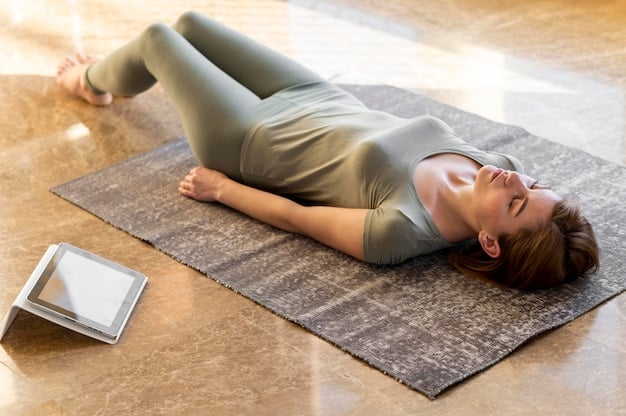Guided Imagery Meditation: Reduce Stress & Find Mental Escape

Guided imagery meditation is a relaxation technique where you use your imagination to create calming mental scenes, helping to reduce stress, improve focus, and promote overall well-being.
Feeling overwhelmed by stress? Discover the power of guided imagery meditation, a simple yet effective technique to escape the pressures of daily life and find inner peace through the power of your imagination.
What is Guided Imagery Meditation?
Guided imagery meditation is a gentle and accessible form of meditation that uses the power of your imagination to create a sense of calm and well-being. Unlike traditional meditation, which often focuses on clearing the mind, guided imagery meditation actively engages your senses to evoke pleasant and relaxing scenarios.
It involves visualizing peaceful scenes, sounds, smells, and sensations to promote relaxation, reduce stress, and even manage pain. Think of it as a mental vacation, a short escape from the demands of daily life.

How Guided Imagery Works
The process of guided imagery meditation is surprisingly simple. It typically involves listening to a narrator or guide who leads you through a specific scene or experience. This guide will use descriptive language to help you imagine the environment and engage your senses.
For example, a guided meditation might take you to a beach, encouraging you to visualize the sand beneath your feet, the sound of the waves, and the warmth of the sun on your skin. By focusing your attention on these sensory details, you can effectively quiet your mind and ease tension.
- Engagement of the senses: The technique emphasizes using all five senses to make the visualization more vivid and real.
- Focus on positive imagery: Guided meditations usually focus on scenarios that are inherently calming and pleasant.
- Active participation: Unlike passive relaxation techniques, guided imagery requires active participation of the mind.
Guided imagery effectively taps into the mind-body connection. During visualization, your brain behaves as if you are actually experiencing the described environment. This leads to physiological changes such as a decrease in heart rate, lower blood pressure, and reduced muscle tension.
Benefits of Guided Imagery Meditation for Stress Reduction
One of the most significant benefits of guided imagery meditation is its ability to effectively reduce stress and anxiety. By creating a mental escape, it provides a break from the worries and pressures of everyday life. This can lead to a cascade of positive effects on both your mental and physical health.
Stress is a common trigger for various ailments, from headaches to digestive problems. Regular practice of guided imagery can help manage these stress-related symptoms and improve overall well-being.
Mental and Emotional Benefits
Beyond reducing stress, guided imagery has several positive effects on mental and emotional health. It can help to improve mood, increase self-awareness, and foster a sense of emotional resilience.
Regular sessions can also promote feelings of hope, optimism, and self-compassion, essential components of mental well-being. It can also be a helpful tool in managing the symptoms of anxiety disorders and depression.
- Improved mood: Visualizing positive scenarios can increase feelings of happiness and contentment.
- Enhanced self-awareness: Becoming more attuned to your thoughts and feelings through meditation.
- Increased emotional resilience: Developing a greater ability to cope with challenging situations.
Guided imagery can be particularly useful for those struggling with emotional regulation. It provides a safe and controlled environment to explore and process difficult emotions, leading to a greater sense of inner peace.
How to Practice Guided Imagery Meditation
Getting started with guided imagery meditation is simple, accessible, and does not require special equipment or training. With a few basic tools and a little bit of practice, anyone can learn to use this technique to reduce stress and improve their overall well-being.
Whether you prefer to meditate alone or with a guide, there are several ways to incorporate guided imagery into your daily routine.
Finding a Quiet Space
The first step in practicing guided imagery meditation is finding a quiet and comfortable space where you can relax without distractions. This could be a dedicated meditation room, a cozy corner in your home, or even a peaceful spot outdoors.
Make sure the space is free from noise and interruptions, and that you feel comfortable and safe. Some people find it helpful to dim the lights, light a candle, or use essential oils to create a more relaxing atmosphere.
Using Guided Meditation Resources
There are many guided meditation resources available online, including apps, websites, and YouTube channels. These resources offer a variety of guided imagery meditations, ranging from short 5-minute sessions to longer, more immersive experiences.
Experiment with different guides and scenarios to find the ones that resonate most with you. Look for narrators with a soothing voice and visualizations that appeal to your personal interests and preferences.
- Meditation Apps: Apps like Headspace and Calm offer a wide range of guided imagery options.
- YouTube Channels: Many channels offer free guided meditation sessions.
- Online Courses: Some websites provide structured courses in guided imagery meditation.
With a little bit of exploration, you can discover a world of guided meditation resources that can help you transform your stress and anxiety. Try to find a routine and resources that best fits you and your needs.

Creating Your Own Guided Imagery Scripts
Once you become familiar with guided imagery meditation, you may wish to try creating your own guided imagery scripts. This can be a rewarding way to personalize the experience and tailor it to your specific needs and preferences.
Creating your own scripts enables you to explore your favorite places, engage your unique interests, and address any specific concerns or challenges you may be facing.
Choosing a Scene
Start by choosing a scene that you find particularly calming and enjoyable. This could be a real place you have visited, or an imaginary location that you create in your mind.
Think about what makes this scene so appealing to you. Is it the sound of nature, the warmth of the sun, the smell of fresh flowers? Engage all of your senses to make the visualization as vivid as possible.
Adding Sensory Details
Once you have chosen your scene, begin to add sensory details to bring it to life. Describe the sights, sounds, smells, tastes, and textures of your chosen environment.
Use descriptive language to paint a picture in your mind and engage your imagination. For example, instead of simply saying “the beach,” you might say “the white sand stretches out before you, warm and soft beneath your feet. The waves crash gently on the shore, creating a soothing rhythm. The air smells of salt and sea.”
- Sights: Describe colors, shapes, and landscapes.
- Sounds: Incorporate natural sounds like birds, waves, or wind.
- Smells: Include pleasant aromas like flowers, pine trees, or fresh air.
By adding these sensory details, you can create a truly immersive and relaxing experience that is uniquely tailored to your personal preferences.
Integrating Guided Imagery into Your Daily Routine
The benefits of guided imagery meditation are best realized through consistent practice. Integrating it into your daily routine, even for just a few minutes, can have a profound impact on your stress levels, mood, and overall well-being.
The key is to find a way to make guided imagery a regular part of your day, just like brushing your teeth or drinking your morning coffee.
Setting a Regular Time
One of the best ways to integrate guided imagery into your daily routine is to set a regular time for practice. This could be first thing in the morning, during your lunch break, or before you go to bed.
Choose a time when you are least likely to be interrupted and when you feel most relaxed and receptive. Consistency is key, so try to stick to your chosen time as much as possible.
Combining with Other Relaxation Techniques
Guided imagery can be effectively combined with other relaxation techniques, such as deep breathing exercises, yoga, or progressive muscle relaxation.
Experiment with different combinations to find what works best for you. For example, you might start with a few minutes of deep breathing to calm your mind, followed by a guided imagery meditation to deepen your relaxation.
- Deep Breathing: Enhances relaxation and reduces anxiety.
- Yoga: Promotes physical and mental well-being.
- Progressive Muscle Relaxation: Reduces muscle tension and stress.
By combining these techniques, you can create a more comprehensive and effective relaxation routine that helps you manage stress and improve your overall well-being.
Overcoming Challenges in Guided Imagery Meditation
While guided imagery meditation is generally a safe and accessible practice, some people may experience challenges along the way. These challenges can range from difficulty visualizing to feeling restless or distracted during meditation.
Understanding these challenges and learning how to overcome them can help you stay motivated and continue to reap the benefits of guided imagery meditation.
Dealing with Distractions
One of the most common challenges in meditation is dealing with distractions. Your mind may wander, you may hear noises, or you may feel restless or uncomfortable in your body.
When distractions arise, try not to judge yourself or get frustrated. Simply acknowledge the distraction and gently redirect your attention back to the guided imagery.
Improving Visualization Skills
Some people may find it difficult to visualize scenes and sensations during guided imagery meditation. If you are one of these people, don’t worry – visualization is a skill that can be developed with practice.
Start by focusing on one sense at a time. For example, try to imagine the color blue, then the sound of rain, then the smell of coffee. With practice, you will find it easier to create vivid and immersive mental images.
- Focus on one sense at a time: Practice visualizing colors, sounds, smells.
- Use real-life references: Draw inspiration from your own experiences.
- Be patient: Visualization skills improve with consistent practice.
Remember that the goal is not to create a perfect or realistic visualization, but to engage your imagination and allow yourself to relax and enjoy the experience.
| Key Point | Brief Description |
|---|---|
| 🧘 Mental Escape | Use imagination for calming escape. |
| 🧠 Stress Reduction | Effective tool for lowering stress. |
| 🎧 Guided Resources | Apps and scripts for meditation. |
| 🌱 Daily Integration | Consistent practice improves results. |
FAQ
▼
It’s a method of focused relaxation that helps create mental images to promote calmness. You use your imagination to reduce stress and enhance well-being by visualizing peaceful scenes.
▼
Yes, guided imagery is suitable for nearly everyone. It is a simple technique and does not require any prior experience. You just need a willingness to use your imagination.
▼
You can practice guided imagery as often as you like. Daily practice is ideal but even a few times a week can provide benefits for stress reduction and emotional well-being.
▼
It’s normal for visualization to be challenging at first. Don’t become frustrated. Focus on the senses you can easily engage, and your visualization skills will improve with consistent work.
▼
Guided imagery is generally safe. However, individuals with severe mental health conditions should consult a healthcare provider before starting, to make sure it is an appropriate technique.
Conclusion
Guided imagery meditation offers a powerful and accessible tool for managing stress and enhancing your overall well-being. By harnessing the power of your imagination, you can create relaxing mental escapes that promote calmness, reduce anxiety, and improve your sense of inner peace. Embrace the practice and discover the remarkable benefits it brings to mind and body.





